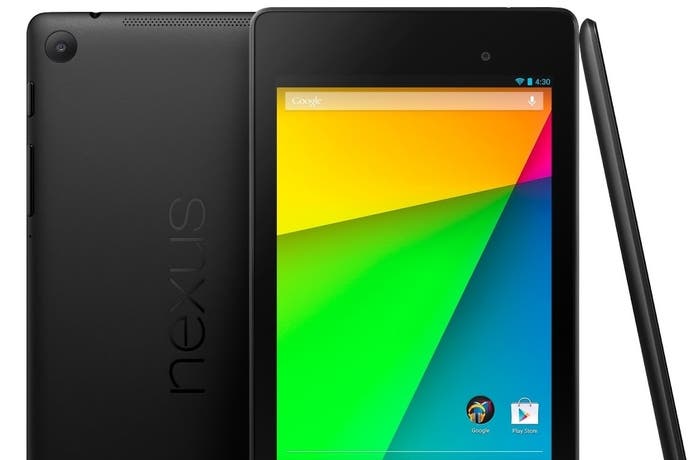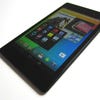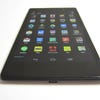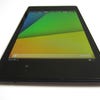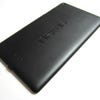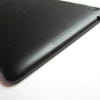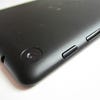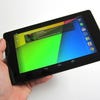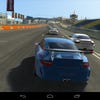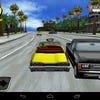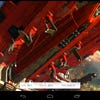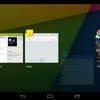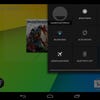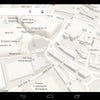Google Nexus 7 2013 review
Revolution or evolution?
Although Google has surpassed Apple's lead in the smartphone arena, it often finds itself lagging behind its Cupertino-based rival in other sectors. Google was almost laughably late to the tablet party, seemingly content to indulge in flaccid projects such as Motorola's expensive and underwhelming Xoom slate than to actively chase the lead established by the almost iconic iPad. However, 2012 marked the year when Google finally did what it should have done eons ago - it saw the launch of the Nexus 7, a collaboration between the search giant and Taiwanese manufacturer Asus. By offering cutting-edge technology at a price which undercut practically every tablet maker on the market, Google was able to claw back valuable market share.
Twelve months on, and we've been given the first update of that concept in the shape of the 2013 model, which retains the Nexus 7 name. In many respects it feels like an incremental update, thanks largely to the fact that the OS - which is still Android Jelly Bean - hasn't evolved a great deal. However, there are notable enhancements to be found: a rear-facing 5-megapixel camera, a better screen and a faster processor. The new Nexus 7 is also thinner and lighter than its forerunner, and feels more sturdy and expensive.
While the original version of the Nexus 7 was an attractive proposition, it was clearly constructed on a shoestring budget. The faux-metallic plastic edging hardly made the slate drip with class and sophistication, and the plastic back could be snapped off with relative ease. There were also reports of issues with the screen, which would bulge away from the casing when the unit became hot during use. Mercifully, Google and Asus have taken such comments on board and created a successor that avoids such pitfalls.
With a thickness of 8.56mm and an overall weight of 290 grams, the 2013 version of the Nexus 7 is thinner and weighs less than its predecessor. It's a fraction taller, but the bezels on the side of the screen - when held in portrait - have been reduced, making it less wide and much easier to cradle in one hand. Strangely, the bezels at the top and bottom of the display (again, when held in portrait) remain practically unaltered; this gives the new model a slightly awkward appearance, with large black borders sandwiching the display.
The tacky silver plastic edging has been removed and is replaced by the wrap-around casing of the tablet itself; you can't pop the back off this version as you could with the earlier Nexus 7, as this is a totally sealed unit in every sense. The casing also lacks the dot-effect texture of the 2012 offering, but retains the soft-touch coating to increase grip.
This coating is quite susceptible to marks and scratches however, so some kind of case might be in order if you're particularly fastidious about keeping your devices in pristine condition. The power and volume controls reside on the right-hand edge of the device - right next to the camera - and there's a Micro USB charging and data port at the bottom edge, which means you can use a standard mobile charger and aren't lumbered with carrying a proprietary power supply around with you at all times.
There's no Micro SD card slot - in keeping with previous Nexus models - but the tablet is available in 16GB (£199/$229) or 32GB (£239/$269) configurations. The previous model's entry-level 8GB offering simply didn't offer enough space for serious downloaders, so upping the basic capacity was a wise move on Google's part. Although it remains a WiFi-only device at present, a cellular edition with 4G capability is due to hit the market this month, and will command a price premium.
"Gaming performance is much improved over the Nexus 7, and it's a little faster than the Nexus 10 too, but 3D game frame-rates are inconsistent."
As the name suggests, the Nexus 7's screen remains seven inches from corner to corner, but this time around boasts a resolution of 1920x1200 pixels - that's a pixel density of 323ppi, trumping the similarly-sized iPad mini. The 2012 model had a bold and bright display, but the one featured here is even more striking; viewing angles are excellent and the IPS LCD panel packs a serious punch, even when it's not at the full brightness setting. When compared directly with the display on last year's model at full brightness the difference is plain to see; colours are bolder and there's a better degree of contrast.
Similar to the release of the third generation iPad, it's in the move to a seriously pixel-rich display that the Nexus 7 sees its most impressive upgrade. It's in this respect that the gauntlet is well and truly thrown down in front of the iPad mini, which must surely see a jump to a similar resolution when the product is inevitably refreshed later this year. Another pleasant surprise is the power of the surround sound speakers, created in conjunction with Fraunhofer IIS - the people who invented the MP3 compression format.
The original Nexus 7 made headlines for its use of Nvidia's Tegra 3 chipset, but for the sequel Google and Asus have opted for Qualcomm's Snapdragon S4 Pro, clocked at 1.5GHz. This consists of a 1.5GHz quad-core Krait 300 and an Adreno 320 GPU, complemented by 2GB of RAM - essentially the same guts as the Nexus 4 mobile phone. As you can see from the benchmarks, we're looking at a generational leap in overall performance, with the new Nexus wiping out its predecessor and the iPad mini, and even besting the larger Nexus 10. However, outside of demanding benchmarks, the user experience in general tablet tasks isn't that much removed - it's similar to comparing the iPad mini to the iPad 4 in fact: pixel density and 3D apps aside, there's no revelatory difference in general usage.
| Nexus 7 2013 | Nexus 7 2012 | Nexus 10 | iPad 4 | iPad mini | Nvidia Shield | |
|---|---|---|---|---|---|---|
| Geekbench 2 | 2620 | 1576 | 2345 | 1773 | 753 | 4335 |
| Sunspider 0.9.1 (Java) | 763.6ms | 1735.8 | 873.3ms | 840.8ms | 1606ms | 396.3ms |
| Kraken 1.1 (Java) | 10513.8ms | 25100ms | 7930.5ms | 16699.9ms | 36261.4ms | 7192.7ms |
| GFX Bench 2.7 T-Rex HD (offscreen) | 15fps | 3fps | 12fps | 16fps | 3fps | 24fps |
| GFX Bench 2.7 Egypt HD (offscreen) | 39fps | 10fps | 39fps | 50fps | 15fps | 65fps |
| 3DMark Ice Storm | 11489 | 4364 | 7769 | - | - | 19527 |
| 3DMark Ice Storm Extreme | 6750 | 2874 | 5258 | - | - | 11476 |
The 2013 model of the Nexus 7 ships with Android 4.3 Jelly Bean - the previous tablet was the first device to hit the market with 4.1 installed, and its successor is the first to receive this improved variant. Like the Nexus 7 itself, it's very much an incremental update, offering slight improvements rather than sweeping changes. Restricted profiles represent the biggest change, allowing you to lock-down accounts to prevent unwanted in-app purchases - handy if you have young children who use your tablet and you don't want them spending countless amounts of cash on Candy Crush Saga. Other enhancements include Bluetooth low energy compatibility, OpenGL ES 3.0 support for improved graphics and changes to the filesystem to avoid slowdown issues which impacted the original Nexus 7.
Android continues to mature as an OS, with app and game support growing by the week. Android 4.3 - when twinned with the Nexus 7's powerful processor and excellent screen - also feels closer to Google's dream of a perfect tablet OS than ever before. It may lack the smoothness and finesse of iOS, but it's more customisable, pleasing those who like to have full control over their experience, rather than a locked-down (but more stable) offering.
Those large spaces at the top and bottom of the tablet may look odd, but they help it from a gaming perspective - they allow plenty of room to grip the tablet without obscuring the display. The 2013 Nexus 7 provides an excellent platform for interactive entertainment; it's light enough to not cause any strain on your wrists from prolonged play, and the bright screen is a joy to game on.
"The overall experience is best summed up by the OS - we're looking at a useful evolution over last year's offering rather than a real game-changer."
It's far from a faultless experience, however - complex 3D titles like Real Racing, Crazy Taxi and Asphalt 8: Airborne suffer from slightly jerky frame rates, although it's never bad enough to seriously impede your enjoyment. Less demanding titles - such as 2D outings like Angry Birds: Star Wars, Jetpack Joyride and Tiny Thief - run without a hitch.
Google and Asus took the brave decision to launch the 2012 model of the Nexus 7 without a rear-facing camera - a move we applauded, as taking photos with a tablet not only looks absurd, it's also awkward and impractical. However, the two companies have relented in this updated edition and have included a 5-megapixel snapper on the back of the slate. Given the low price it was always going to be somewhat naive to expect it to be a world-beating photographic device, and the shots taken are fairly underwhelming. The front-facing 1.2 megapixel camera remains, but is placed oddly off-center, to the right-hand corner of the tablet. Its main use is for video calls over services such as Skype and Google's own Hangouts, and it performs this task admirably.
The one area where the 2013 Nexus 7 is inferior to its 2012 counterpart is the capacity of its internal battery. Last year's model came equipped with a 4325mAh power cell, but the sequel can only muster 3950mAh - although the introduction of Qi wireless charging does mitigate this somewhat. Google and Asus have claimed that the drop in capacity doesn't mean less juice thanks to optimisations within Android, and that may well be the case. We managed to squeeze about eight hours of use from the Nexus 7 before it needed a top up - pretty much equivalent to the stamina of our 2012 model.
"Tablet photography has always been unwieldy and nothing changes with the new Nexus 7. Results from the 5-megapixel sensor fail to impress."




Google Nexus 7 2013: the Digital Foundry verdict
The original Nexus 7 was a genuine game-changer - an Android tablet that was reasonably priced and offered incredible power and a version of Google's OS which actually worked properly on a large-screen device. This 2013 model takes the concept to a new level, bringing a massively improved display, more processor muscle and a 5-megapixel rear-facing camera. It's also physically a much more appealing prospect, offering a thinner, lighter frame marred only by the large areas of space at the top and bottom of the screen.
Despite all of the enhancements, this is still a largely incremental upgrade, however - a point that should go without saying when you consider the short amount of time that has elapsed between the two devices hitting the market, but one worth making all the same. If you've already got a 2012 Nexus 7 and you're perfectly content with it, rushing out to purchase this follow-up may not be the best idea. Granted, the 2013 edition does things faster and in a more slick manner, while the display is clearly much improved, but it's not as if last year's version is obsolete - it has been granted Android 4.3 as well, so from a software perspective it's just as up-to-date as its newer relation.
This new Nexus 7 arguably makes more sense to those who are upgrading from an older tablet or have never owned a 7-inch slate previously; it's also a good entry point for existing iPad owners who perhaps wish to experience what life is like on the other side of the fence. For its price, the Nexus 7 puts the iPad mini to shame, but it's worth remembering that build quality isn't up to Apple's lofty standards and the Google Play market continues to sit in the shadow of the iOS App Store - although the once gigantic gap which existed between the two has narrowed somewhat as the months have passed.
Irrespective of what position you approach the 2013 Nexus 7 from as a consumer, there's no denying that it's an exceptional slab of tech for the price.
